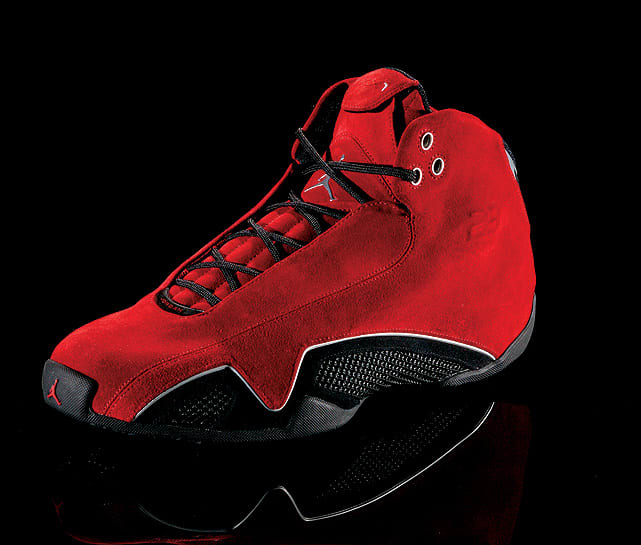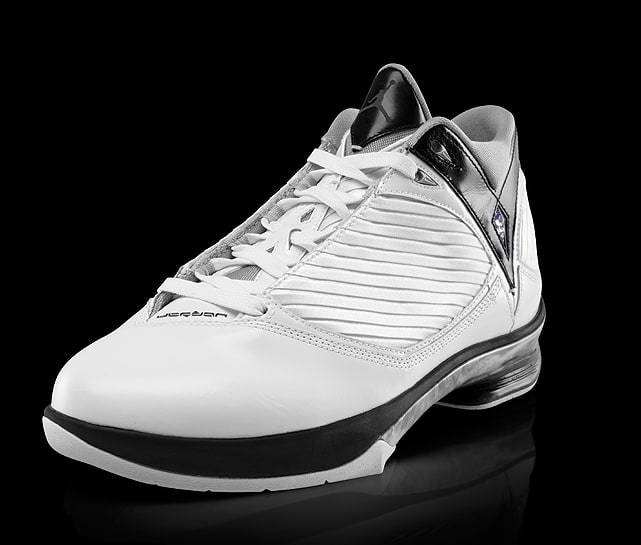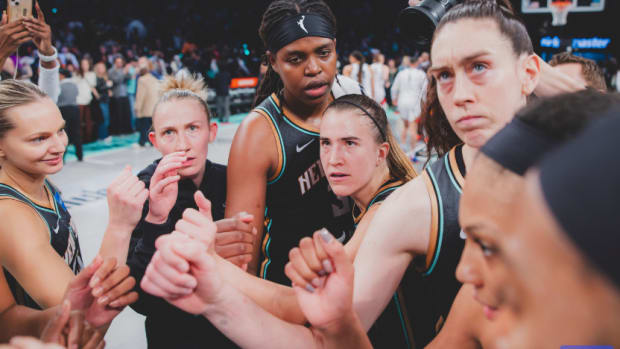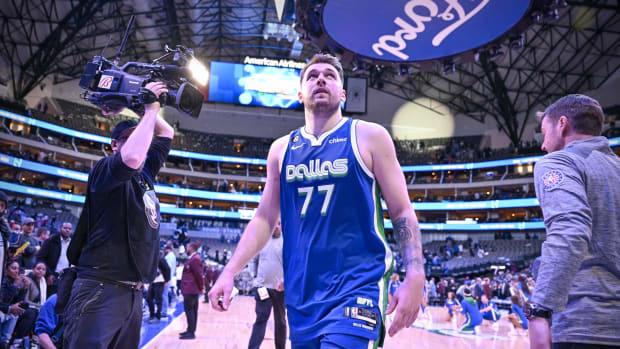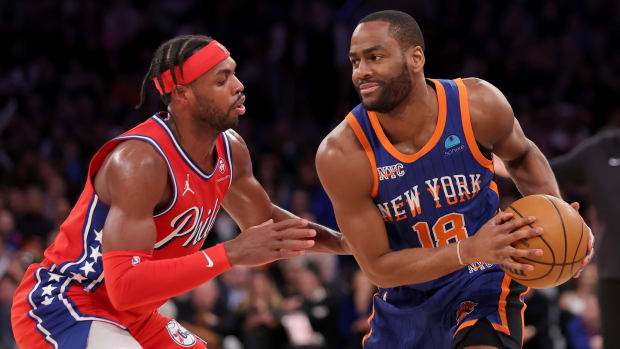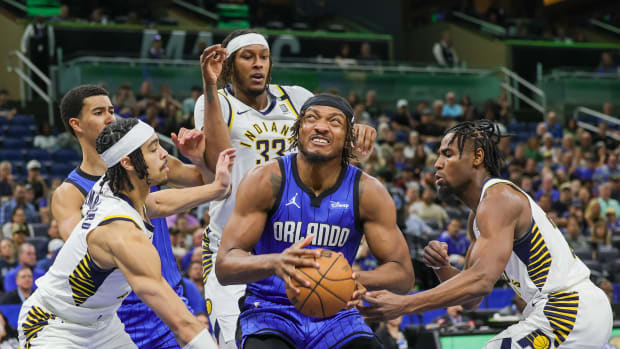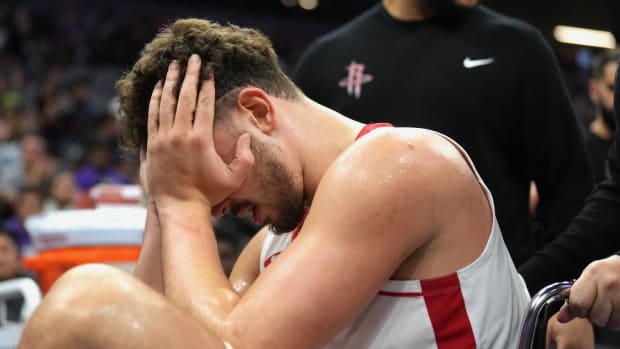Sneaker reviews: Nike Basketball wear test provides hardwood answers
A sneaker sitting in a box or donning feet for fashion doesn’t exact the same needs as one hitting the hardwood for real hoops use. Nike—and subsidiary Jordan Brand—knows how to sell basketball sneakers, whether for fashion or hardwood. The numbers tell the story, as the two groups combine for over 95% of all basketball sneaker sales in the U.S. LeBron James leads the way. Kevin Durant and Kobe Bryant help keep pace. With those three big sellers—not to mention the new Kyrie Irving signature—what’s the Nike Basketball shoe for you, assuming, of course, you plan to hit the hardwood?
SI.com did a wear test of some of Nike’s (not Jordan Brand, mind you) most popular models, weighing the pros and cons of each shoe. Each signature shoe has multiple lines, sometimes coming in “Elite” materials, differing low top vs. high top cuts and more. For simplicity, we reviewed the mainline model of each shoe.
- MORE: SI.com's Sneaker Hub: All the latest news, releases and more
LeBron 12
Twelve shoes in and Nike still brought out something completely new when it unveiled the LeBron 12 in Fall 2014. The new-to-Nike hexagonal Air Zoom cushioning system was mapped to specific pressure points under the foot.
Using air cushioning in Nike basketball shoes sets them apart from the other brands. And while some Nike shoes mix and match the air and the foam (or skip air altogether), the LeBron 12 fully embraces the air—for a complete breakdown on basketball cushioning, read this story—with the new pattern.
On the court, the air cushioning doesn’t have the same give as a foam, but it does provide stability. You can feel the thick footbed underfoot that provides comfort and cushioning, even if not plush.
The high top provides stability that combines with the footbed for an overall sense of security.
While lighter on your foot than you might originally think, the LeBron 12’s deficiency lies in a slightly loose feeling during more guard-like cuts and moves.
Baseline thought: The LeBron 12 proves solid, stable cushioning, especially for non-guards and big men.
KD7
The KD8 isn’t far from us, the first of the new signature models that Nike will unveil over the next footwear season. But it isn’t out yet, so let’s focus on the KD7, still available now and even once the new option hits shelves.
The strap—the main aesthetic component of the KD7—is more than just fun Velcro: it serves a performance purpose. The ability to tighten the feel, or loosen as the case may be, over the midfoot helps in providing lockdown stability in a way you won’t find from many other basketball shoes.
The KD7 pushes you forward, allowing for quality lateral cutting. The low top cut also creates freer movements, all while keeping you locked in with Flywire and the strap, giving a quality stability quotient in a low top, a strength that some other low top shoes may lack.
The Zoom Air cushioning doesn’t free up as much movement as you would have with a foam, so don’t expect an overly comfortable ride, even thought there is still a softness to the shoe.
Baseline thought: The KD7 offers a quality feel for the medium-range player, similar to KD himself. While not a pure guard shoe, as we’ll see from the Kyrie 1, and not a big-man shoe, the mix of freeing lateral movements and low top lockdown merge with cushioning and support.
Kobe X
The Kobe X has it all, the pinnacle feeling of a Nike Basketball sneaker.
The combination of Lunarlon foam through the majority of the footbed and Zoom Air on the heel provides solid comfort that will last. A reinvented traction pattern combined with flex grooves in the outsole gives the Kobe X tremendous traction ability while allowing the foot to move freely.
A carbon fiber shank in the midsole provides the stability and response during movement other low tops may lack, but still with that solid footbed feel bigger players may require.
A half inner sleeve helps with lockdown feeling and ups the level of comfort. There’s more stability in this low top than you’d expect, especially while enjoying the most natural fit in the Nike line.
Baseline thought: For this tester, nothing felt better than the Kobe X. There isn’t a single area the Kobe X proves deficient, all while giving some top-level comfort, stability and traction.
Kyrie 1
If you’re looking for a shoe for a quick-moving, fast-cutting guard, the Kyrie 1 knows how to match your style. One of the newest in the Nike line, the first signature shoe for Cleveland guard Kyrie Irving was designed around his fast-moving game.
The superior traction sets this shoe apart. Nike says the modified herringbone pattern wraps the sidewalls for maximum traction. This sounds like a fun—if not, superfluous—feature, but on the court you can actually feel the traction, even up the sides, providing incredible lateral movement for a shoe that sits closer to the ground than any other.
The low-cut variety doesn’t offer ankle support, but the lower fit is freeing on the court, allowing for a natural movement of the foot and ankle. Fit-wise, still expect a lockdown feel, especially in the forefoot, and in a molded heel counter.
The one drawback to the Kyrie 1 on the court is the Phylon foam in the heel lacks comfort. And the Nike Zoom unit in the forefoot isn’t a plush cushioning experience.
Baseline thought: Lightweight and quick-moving, the traction and lateral movement construction on this natural-feeling shoe is top-notch, even if you have to sacrifice comfort cushioning to get there.
Hyperposite
At first glance, the Hyperposite is a lot of shoe. There’s no sleekness to the look, leading you to think it will prove enormous once it's on the foot. And while an inner sleeve takes some of the size concerns away, the Hyperposite still feels clunky and heavy on a smaller foot.
That said, the inner sleeve does provides a tight fit, and the combination of Max Air and foam under the heel provides a intensely cushioned footstrike. There’s cushioning throughout this shoe that mixes Nike’s Hyperfuse and Foamposite construction, even adding cushioning in the collar.
For the big man, this shoe provides a ton of stability, lockdown feel and comfort, but guards may not like the bulk and seemingly limited ability to cut quickly.
Baseline thought: The Hyperposite gives support and cushioning for players who focus on those attributes, but don’t expect this to be a quick player’s shoe of choice.
Hyperdunk
Visit any high school gymnasium in the country and you’ll find plenty of Hyperdunk shoes in an array of colors. And there’s a reason for this: The Hyperdunk is a solid all-around shoe.
While many in the Nike line excel in some areas, giving up something in others, the Hyperdunk has the feel of Mr. Mainstay, decent in every category, but not excelling in any.
For cushioning, the full-length Lunarlon is a step up from Phylon and feels plusher out of the box than air, but will wear out over time quicker. The construction mixes in Flywire to give the Hyperdunk a nice lockdown feel, especially for a high top.
On the court, the lightweight shoe provides decent stability, but not an amazing feeling of security. And while comfortable, the Hyperdunk isn’t the most comfortable in the Nike line. Resting on the footbed, there’s stability, but a sense of thinness the light feel.
Baseline thought: The Nike Hyperdunk could be the most above average basketball sneaker out there, versatile for any position and any need. For those in need of an all-around basketball sneaker, there’s no deficiency in the Hyperdunk. Just don’t expect to be wowed.
Final shot
The KD7 still provides a solid tweener shoe, the Hyperposite gives cushion as needed and the Hyperdunk can’t be overlooked, but the results of this wear test set three shoes above the line. The LeBron 12 shows why it sells well, as a strong shoe for mid-sized and bigger players. The Kyrie 1 should be the new choice for quick-moving guards. But, in the end, any player would be hard-pressed to find a combination better than the Kobe X.
Tim Newcomb covers stadiums, design and gear for Sports Illustrated. Follow him on Twitter at @tdnewcomb.
FULL GALLERY:Air Jordans Over the Years
Air Jordans Over the Years
Air Jordan I
Air Jordan II
Air Jordan III
Air Jordan IV
Air Jordan V
Air Jordan VI
Air Jordan VII
Air Jordan VIII
Air Jordan IX
Air Jordan X
Air Jordan XI
Air Jordan XII
Air Jordan XIII
Air Jordan XIV
Air Jordan XV
Air Jordan XVI
Air Jordan XVII
Air Jordan XVIII
Air Jordan XIX
Air Jordan XX
Air Jordan XX1
Air Jordan XX2
Air Jordan XX3
Jordan 2009
Air Jordan 2010
Air Jordan 2011
Air Jordan 2012
Air Jordan XX8
Air Jordan XX9
Air Jordan XXX
























































